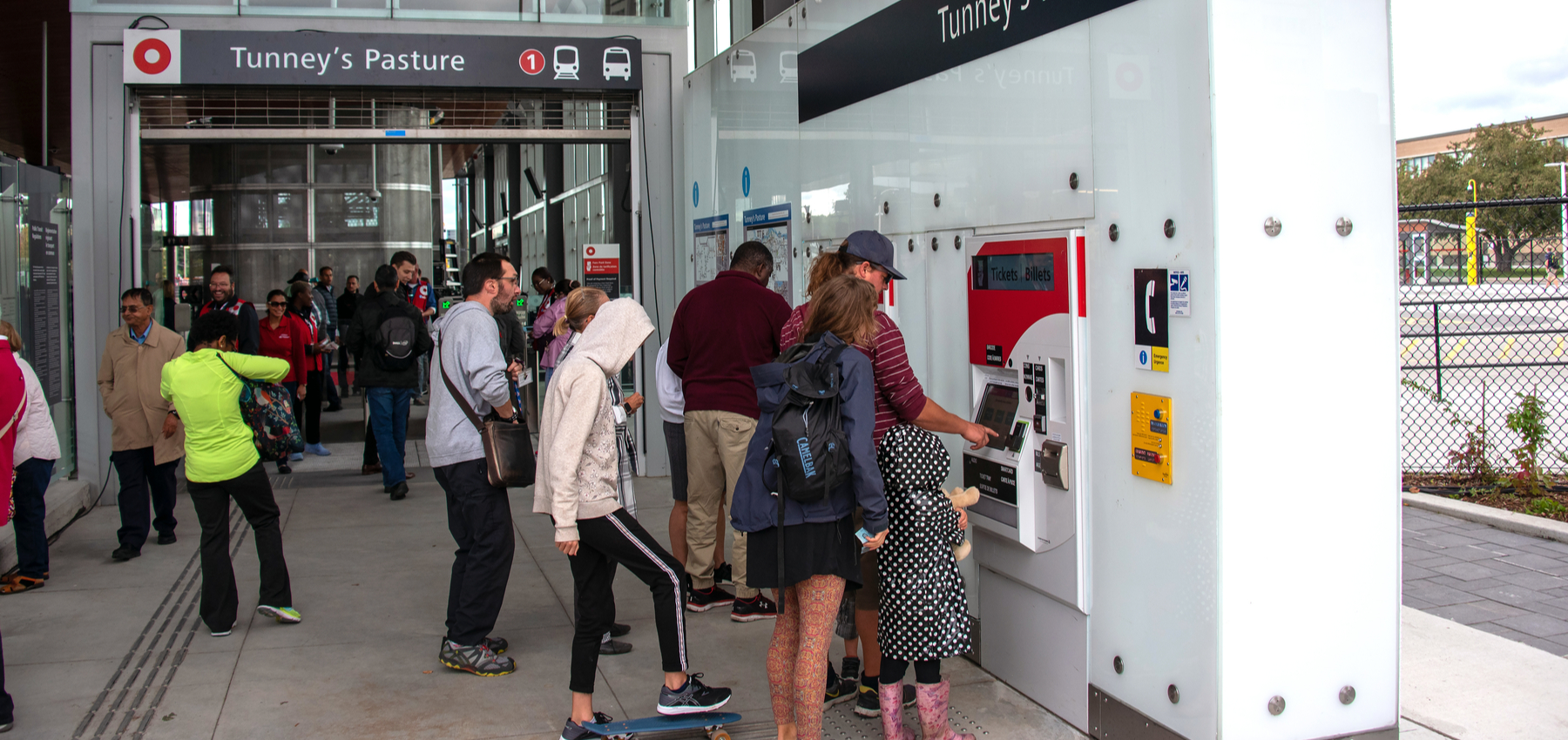For newcomers to the city of Ottawa, navigating the city’s public transportation system is one of the most important tasks of your first few months in Canada. If you choose not to purchase a car or get a driver’s license, public transit will be your primary mode of transportation. This article will explain the Ottawa public transit system so that you can easily travel within the city.
Tip: Learn more about the city of Ottawa, in the province of Ontario, by reading the Ontario provincial spotlight.
The primary transportation agency in Ottawa is OC Transpo. Gatineau, a city just across the river from Ottawa, has its own transit authority, the Société de transport de l’Outaouais (STO). As many people travel between these two cities on a daily basis, the STO and OC Transpo work together on many services.
What types of public transit are there in Ottawa?
Transit stops in Ottawa are marked with a large red ‘O.’ There are multiple forms of public transit in Ottawa to get you to your destination:
O-Train rail
The O-Train rail service has two lines:
- Confederation Line: This electric light rail line is marked by a red circle on OC Transpo signage. It has frequent downtown service and connects to the Trillium line at Bayview station. The end-to-end travel time for this line is only about 25 minutes, allowing you to travel quite quickly through downtown Ottawa on this line.
- Trillium Line: The Trillium line is a diesel-run line marked by a green circle on OC Transpo signage. The line runs north-south between Greenboro and Bayview and is less frequent than the Confederation line. The line runs approximately every 15 minutes with room for only 260 passengers at a time, so be prepared to wait for the next train during rush hour.
The O-Train runs at these hours:
- 5 a.m. to 1 a.m Monday – Thursday;
- 5 a.m. to 2 a.m. Friday;
- 6 a.m. to 2 a.m. Saturday; and
- 8 a.m. to 11 p.m. on Sundays and Holidays.
See more information on the expansion of future O-Train lines.
Bus
The Ottawa bus service includes multiple types of buses, many of which connect you directly to O-Train stations. Buses run 24 hours a day, seven days a week, with more limited nighttime service. Each bus route type serves a different purpose:
- Rapid Routes: Rapid Routes are marked by a blue circle, and travel directly between stations and Park and Ride areas with infrequent stopping. Rapid Routes get you to your destination quickly by operating in bus-only traffic corridors, seven days a week.
- Frequent Routes: Frequent Routes can be located with an orange hexagon marking. They travel frequently on major roadways during weekday work hours (6:00 a.m. to 6 p.m.) and slightly less frequently on the weekends.
- Local Routes: Grey rectangles mark the Local bus routes in Ottawa. Local routes cover smaller, specific areas that the O-Train, Rapid Routes, and Frequent Routes do not cover. Local Routes do not come as frequently as other bus routes.
- Connexion Routes: Connexion Routes are marked by purple ovals. They are intended to bring commuters in from residential areas to the O-Train. Connexion Routes only run on weekdays.
Para Transpo
Ottawa’s Para Transpo service is a shared-ride service for individuals with disabilities that prevent them from taking the bus or O-Train, which picks you up right at your front door. You can use your monthly transit pass to pay for Para Transpo. Find out more about the Para Transpo and how to book it.
Ottawa transit fares: Where and how to pay
Where to purchase your passes
There are many convenient options for purchasing your transit fare. Most transit users use reloadable transit passes called Presto cards, which you can purchase at ticket machines located in all O-Train stations, just outside of the fare paid zones. You can pay with cash, debit, or credit to buy Presto cards, load Presto cards, or buy day passes and single-fare tickets. These products are also available at OC Transpo Customer Service Centres and select Shoppers Drug Mart and Loblaws locations. You can also order your Presto card online at prestocard.ca.
Once you buy your Presto card ($6.00 CAD), you can load it with money or a monthly pass. By registering your Presto card online, you can track your balance, reload your card, and protect your balance from theft or loss. Adult one-way fares cost $3.60 CAD with cash or tickets, with a 5 cent discount applicable when you pay with Presto cards. Monthly passes run for $120.00 CAD per month with discounts available on all fares and passes for students, youth, seniors, and more.
How to pay on Ottawa transit
If you use a Presto card, you can tap it as you enter a bus or at the fare gates of O-Train stations. Your Presto card will calculate the fare needed. If you are paying your fare by cash or ticket, pay at the front of the bus or at a ticket vending machine in an O-Train station.
Tip: Once you pay your fare, you have a 90-minute transfer window to switch to any other transit route (bus or O-Train) to get to your destination.
How to plan your transit route
Use transit maps
Planning your transit route is easier than ever, thanks to internet resources. You can access any of these transit maps with your smartphone either before you leave or while you are travelling.
Use trip planning tools
You can use the OC Transpo trip planning tool before you leave to calculate the shortest route to your destination. Simply input your starting point and ending point, and the time you want to arrive by.
Tip: Rocketman is a Canadian-built transit app that you can use to find out when the next bus or train is arriving, track your bus along its route, save your favourite stops, and get transit delay alerts in real-time. You can download the Rocketman app today for free.
Rocketman is easy to use, showing you only the info you need to get you to your destination on time and with minimal waiting. Riders using the app can even see how full each transit vehicle is before boarding with the Crowdedness feature. This feature works by asking commuters to help other riders by reporting how crowded their transit vehicle is, and the app can display these crowdedness levels so all Rocketman users can be better prepared for their commute.
Cycling and transit in Ottawa
Ottawa has a large network of multi-use pathways that connect directly to O-Train stations for safely combining cycling and transit in your journeys. Bikes are permitted on the O-Train at any time in the designated bike areas. Sheltered bicycle parking is also available at most O-Train stations, along with minor bicycle repair stations.
The Rack & Roll program is working to put bike racks on all Ottawa buses. Currently, many bus routes have bike racks on the front of the bus for you to load your bike onto while you ride. Use the City of Ottawa’s Cycling Map and tools for additional information on combining cycling and transit. Adding cycling to your commute is not only a cost-effective and sustainable choice, but it is also a great opportunity to incorporate exercise into your daily routine.
Tip: Familiarize yourself with Ottawa’s cycling safety rules before travelling on your bicycle.
Benefits of using public transportation in Ottawa
An environmentally-friendly commute
Canadians are always looking for ways to make their lifestyles more sustainable. Using public transit instead of buying or leasing a car is one of the most effective ways to cut down on your personal carbon footprint. By reducing traffic on the roads, we can create a greener future for Ottawa and continue to improve the city’s public transit system.
Tip: You can measure your potential carbon footprint in Canada using Natural Resources Canada’s Greenhouse Gas Equivalencies tool.
Save money on vehicle costs
Vehicle expenses go far beyond the initial purchase; fuel, insurance, maintenance, tires, and parking costs start to add up quickly. By choosing to use the O-Train or bus, or by combining them with cycling, you can save the money that you would have spent on a vehicle.
Convenience of transit
Sometimes, it takes longer to drive downtown and find a parking spot than it does to simply hop on the O-Train. Using public transportation means you are free to travel around the city with no need to check your parking meter or stay close to your car. A ride on transit can also be more productive than driving through rush hour, as you can relax, listen to music, or read a book on the bus or O-Train.
Health benefits
Using transit is a much more active commute than driving due to additional walking, and active participation required to get to your destination. Adding more activity to your daily routine is one of the best ways to consistently support your health. Bringing in cycling adds even more activity and fresh air to your commute.
The overview we have given of the Ottawa public transportation system will hopefully give you the confidence to make transit part of your daily routine — your wallet and the environment will thank you for it. For newcomers, using public transit is one of the best ways to get to know the city and travel to and from work or school.
If you really want to travel like an Ottawa resident, you can strap on your ice skates for your morning commute. In the coldest months of winter, when the Rideau Canal freezes over, some Ottawans get to work by ice-skating over the eight-kilometre stretch of the frozen canal!





